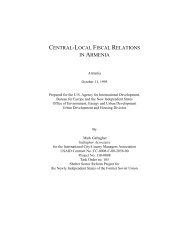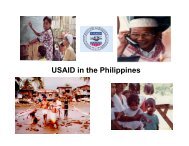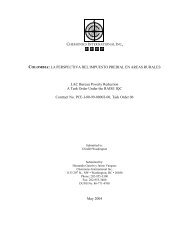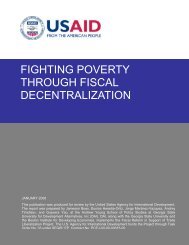Effectiveness and Economic Impact of Tax Incentives in the SADC ...
Effectiveness and Economic Impact of Tax Incentives in the SADC ...
Effectiveness and Economic Impact of Tax Incentives in the SADC ...
You also want an ePaper? Increase the reach of your titles
YUMPU automatically turns print PDFs into web optimized ePapers that Google loves.
TAX SYSTEMS AND INCENTIVES IN THE <strong>SADC</strong> REGION 7-19<br />
7.5 Institutional Framework for <strong>Tax</strong> <strong>Incentives</strong><br />
<strong>Tax</strong> <strong>in</strong>centive programs are characterized not only by tax rates <strong>and</strong> technical provisions <strong>of</strong> <strong>the</strong><br />
tax law, but also by <strong>the</strong> <strong>in</strong>stitutional framework. Without attempt<strong>in</strong>g a detailed review, this<br />
section briefly discusses experience <strong>in</strong> <strong>the</strong> region on three issues: <strong>the</strong> statement <strong>of</strong> objectives;<br />
procedures; <strong>and</strong> fiscal transparency.<br />
OBJECTIVES<br />
In <strong>of</strong>ficial government statements on tax <strong>in</strong>centives or <strong>in</strong>vestment promotion policies <strong>in</strong> <strong>the</strong><br />
<strong>SADC</strong> region, <strong>the</strong> most frequently named objectives are, first, <strong>the</strong> promotion <strong>of</strong> exports (9<br />
countries); second, <strong>the</strong> development <strong>of</strong> manufactur<strong>in</strong>g <strong>and</strong> <strong>in</strong>dustry, or more broadly,<br />
economic diversification (8 countries); <strong>and</strong> third, employment creation (7 countries). O<strong>the</strong>r<br />
expressed objectives <strong>in</strong>clude “upliftment” <strong>of</strong> disadvantaged groups, spatial development, <strong>and</strong><br />
promotion <strong>of</strong> small bus<strong>in</strong>ess development. In four countries, <strong>in</strong>vestment itself is stated as an<br />
objective, though it is better viewed as a means to more fundamental ends, not as an end <strong>in</strong><br />
itself.<br />
Some <strong>of</strong> <strong>the</strong>se <strong>of</strong>ficial statements may be largely rhetorical, but many <strong>of</strong> <strong>the</strong>m have substance.<br />
In particular, most <strong>of</strong> <strong>the</strong> <strong>in</strong>centive programs target export promotion <strong>and</strong> manufactur<strong>in</strong>g<br />
development. In addition, countries that identify small bus<strong>in</strong>ess development <strong>and</strong> spatial<br />
development as objectives generally follow through with specific programs aimed at <strong>the</strong>se<br />
targets (though <strong>in</strong> some cases <strong>the</strong> programs <strong>in</strong>volve f<strong>in</strong>ancial assistance ra<strong>the</strong>r than tax<br />
breaks).<br />
The employment objective is a genu<strong>in</strong>e goal <strong>in</strong> every <strong>SADC</strong> country. Ironically, many <strong>of</strong> <strong>the</strong><br />
tax <strong>in</strong>centives work at cross purposes to <strong>the</strong> goal <strong>of</strong> job creation by favor<strong>in</strong>g capital-<strong>in</strong>tensive<br />
activities <strong>and</strong> technology choices, by virtue <strong>of</strong> structur<strong>in</strong>g benefits as a function <strong>of</strong> capital<br />
costs. 104 A more coherent policy design would not depend on tax breaks for capital, as such,<br />
but would focus <strong>in</strong> <strong>the</strong> first <strong>in</strong>stance on lower<strong>in</strong>g tax rates to stimulate efficient <strong>in</strong>vestment<br />
generally, without tilt<strong>in</strong>g <strong>the</strong> field toward capital <strong>in</strong>tensity.<br />
As for uplift<strong>in</strong>g disadvantaged groups, tax <strong>in</strong>centives for manufactur<strong>in</strong>g, exports, <strong>and</strong> so forth<br />
are a very roundabout way to achieve this end. Direct expenditure programs can be far more<br />
efficacious. If tax breaks cause a significant loss <strong>of</strong> revenue, <strong>the</strong>n <strong>the</strong>y can produce <strong>the</strong><br />
opposite effect by reduc<strong>in</strong>g fiscal resources for expenditure programs aimed at poverty<br />
reduction.<br />
104 Differences <strong>in</strong> factor <strong>in</strong>tensity can be huge. Consider, for example, <strong>the</strong> fact that <strong>the</strong> $1.3 billion Mozal project<br />
<strong>in</strong> Mozambique created fewer than 700 direct jobs; whereas $2.1 billion <strong>of</strong> labor-<strong>in</strong>tensive <strong>in</strong>vestments by<br />
Taiwanese companies <strong>in</strong> South Africa, Swazil<strong>and</strong>, <strong>and</strong> Lesotho have created 110,000 direct jobs. Source on <strong>the</strong><br />
Taiwanese <strong>in</strong>vestment: Speech by Taiwan liaison <strong>of</strong>fice <strong>in</strong> South Africa, June 12, 2003. http://www.roctaiwan.org.za/press/20030612/2003061201.html.











